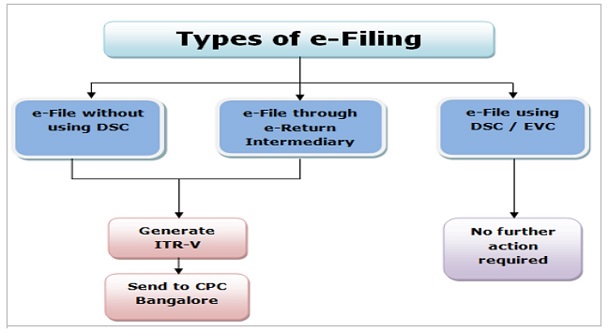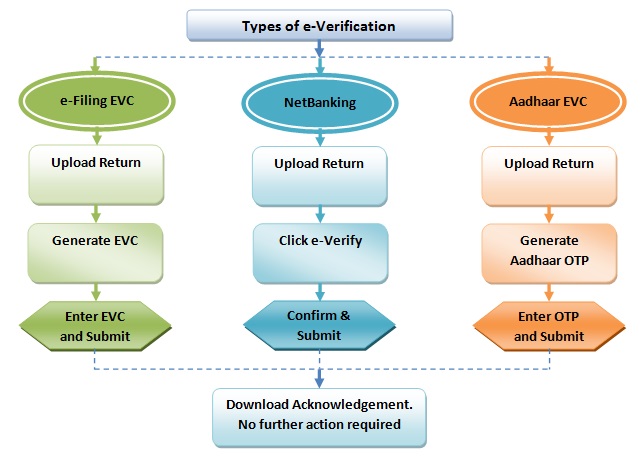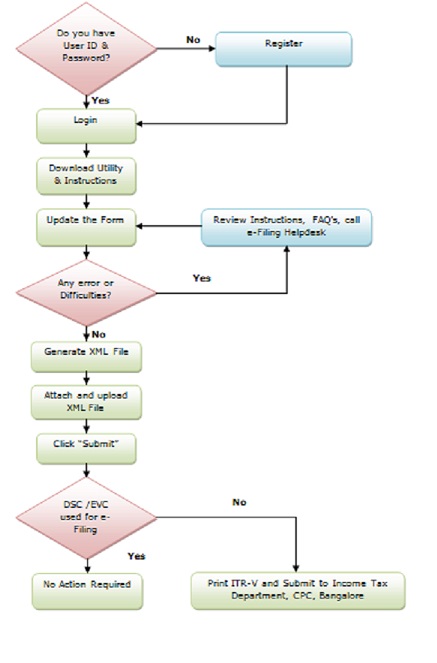 |
|
||||
|
|
|||||
What is E-Filing or What is Procedure For Filing E-Income Tax Return
by
Rajesh Goyal

|
Ads by Google
What is e-filing : The full form of e-filing is “Electronic Filing”. In view of expansion of internet, e-filing has not only been popular but is also mandatory in large number of cases. E-filing is The process of submitting tax returns over the Internet, using tax preparation software that has been pre-approved by the relevant tax authority.
Who are Required to E-file their Tax Returns in India : There are number of cases where Income Tax Department has made it mandatory to e-file the returns. However, we can in brief say that for individuals with salary income or so and using ITR1 and ITR2, e-filing is mandatory if the gross income exceeds Rs 5 lakhs or the individual intends to claim refund of the tax already deducted / paid. In case you are not covered by this, you need to check the cases where it is mandatory to e-file the return.
Procedure for E-filing or How to File Your Income Tax Return Online : The income-tax department has started an independent portal for e-filing tax returns —www.incometaxindiaefiling.gov.in. As per the procedure, Returns can be e-filed either with or without a digital signature. Those who e-file returns without a digital signature need to take a copy of form ITR-V, sign it and send it within a specified period (120 days) to a specified address (Income Tax Department – CPC, Post Bag No. 1, Electronic City Post Office, Bengaluru–560100, Karnataka) by ordinary or speed post. In case the return has been filed with digital signatures you need to send the ITR-V by post. The biggest advantage of e-filing of tax returns is that you can do this from any place at any time, thereby saving a lot of time and effort. It is simple, easy and faster than filing returns manually. Income Tax Department also has a Help Desk and in case of queries on e-filing of return, the taxpayer can contact 1800 4250 0025.
What Documents You Must Have Ready to File A E-Tax Return : Before you start filing your income tax return, there is plenty of ground work and documents to be collected so that you can easily file the tax return and there are no discrepancies. Some of the documents you need to collect before you sit for actual filing of income tax are summaried here:- (a) Your PAN Card, your e-filing password, your bank statements across all the accounts you operate (including loan accounts) (b) Your tax returns also ask for your Aadhar and passport numbers — it is an optional detail, but ifyou have both, take those as well. (c) Form 16 (for Salary payments) and Form 16A (for income from other sources, eg by banks for the interest paid to you) from all the entities which have made payment to you and deducted TDS;
(d) If you trade in shares, your D-Mat account details alongwith the details of the transactions to prepare your gain / loss on shares. Prepare Capital Gain / Loss Statement as Short term loss can be offset against short term and long term capital gains during the same period
(e) Principal and interest payment certificate from loan provider (if applicable for claiming deductions): This is needed as you need to know actual amount you paid towards your home loan principal and interest (separately) to claim tax deductions under Section 80C and section 24 respectively.
(f) Verify your tax credit statement : Form 26AS has now become very important as it gives you the details as how much tax money was credited on your behalf via TDS. This amount should match the TDS amount you have from form 16 and form 16A. If these do not match, you are likely to get a notice from Income Tax Department for explaining the reasons for the difference. (g) Long term loss can only be offset against long term gains during the same period (h) Challans of Advance Tax or Self Assessment Tax as details of the same are required to be filled in the return; (i) Bank account statements to know the amount of interest paid by your banks on your saving bank accounts. You should recheck the credits of the saving bank account to find out whether any credit has remained unaccounted for;
(j) Details of insurance payments and donations, and if you are a freelancer or an independent professional, your credit card bills. (k) The details of your investments / payments which are allowed as deductions in Section 80 : We know various deductions (about 17 in number) are allowed under sub-sections of Section 80. The most popular sections availed by people are deductions under i) 80C : Under this Section (including 80CCC and 80CCD) we get deductions for payments that have been made towards Life Insurance, PF and PPF Schemes and other unit linked savings schemes. The maximum deduction that is allowed under this section is Rs.1,50,000,, ii) 80D deductions are exclusively for medical and health insurance premium payments. The deduction is, limited to Rs.15,000 if the premium paid is just for yourself, increases to Rs.20,000 for yourself and your spouse, and goes upto Rs.40,000 if it is paid for yourself and your parents who are senior citizens iii) 80TTA 80TTA covers Savings Bank interest, which is deductible up to Rs.10,000) and iv) 80G (Under this section, deduction is available to any tax payer making donation to the company. 50% of the donation made is allowed to be deducted from the taxable income and consequently tax is calculated)
(A)Other Pre-Requisites For E-Filing of Income tax Return : · A user must register at https://incometaxindiaefiling.gov.in · PAN (Permanent Account Number) https://incometaxindiaefiling.gov.in/e-Filing/Registration/RegistrationHome.html is the direct link for registering yourself. For registering yourself, you will need to provide PAN, Password details, Personal details as per PAN, Contact details and Digital signature (if available and applicable). And Submit these details. On successful acceptance of the details, Activation link will be sent to user through e-mail and a mobile PIN to mobile number. Click on the activation link and provide Mobile PIN to activate e-Filing account. Once the above procedure, you should note down your LOGIN details (vis login User ID, Password , Date of Birth/ Incorporation date) etc. as these will be required next time you login to your account.
(B) Methods for Filing of E-Return : Income Tax E-return can be down online through the income tax website without any charges in the following two methods:- (i) Download the ITR Excel Utility or ITR Java Utility and furnish the details in the Excel uility offline and then upload the same on income tax website;
https://incometaxindiaefiling.gov.in/e-Filing/Services/DownloadItrLink.html
(ii) Income Tax e-filing without downloading the Jaya Utility and furnishing all details online itself.
The feedback indicates that people find Java Utility to be easier than the Excel utility. However, you may use the utility which you feel to be easier.
(C)Various Types of E-Filing : There are three ways to file Income Tax Returns electronically:
Ads by Google
(D) Types of e-Verification of Returns
Source : Income Tax Department website E-Filing ProcessIncome Tax Department on its website: https://incometaxindiaefiling.gov.in/ has given the following diagram which beautifully sums up the e-filing process / procedure, which we have tried to explain above.
Source : Income Tax Department website NOTE : We have tried to explain the details of e-filing in a systematic and easy to understand method. However, those who wish to read the full details and updated information visit the website of income tax department.
|
|
|


